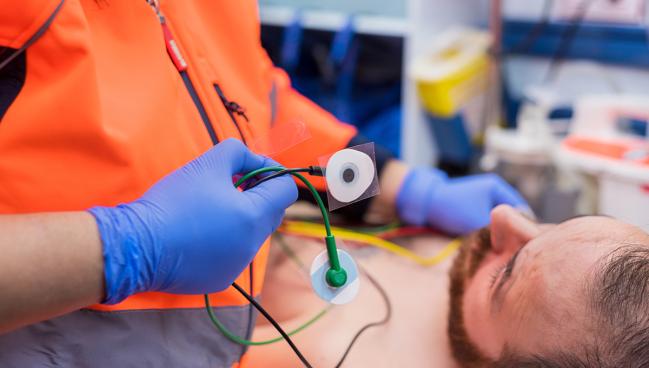Many ACS Patients With Occlusions Are Falling Through the Cracks
NSTEMI patients with blockages are delayed getting to the cath lab and fare worse than their counterparts with STEMI.

PARIS, France—Among patients with acute MI and occlusive disease on invasive angiography, those presenting without ST-segment elevation on the initial ECG fare worse than those with STEMI, researchers found.
Despite having similar baseline characteristics and angiographic findings, NSTEMI patients had a significantly higher risk of mortality at 1 year compared with STEMI patients (HR 1.45; 95% CI 1.02-2.07), “and we believe that this excess mortality is actually driven by the delays to coronary angiography relating to the poor ECG interpretation at presentation,” Robert Herman, MD (University of Naples Federico II, Naples, Italy, and Cardiovascular Center Aalst, Belgium), said Friday at EuroPCR 2023.
Indeed, the median time to angiography was 1.4 hours for patients with STEMI and 16.3 hours for those without ST-segment elevation, even though patients in both groups ultimately were found to have occluded vessels.
“Our study highlights the impact of relying on just STEMI criteria as the means of identifying occlusive ACS, and warrants the adoption of more-sensitive criteria to detect occlusion in these patients,” Herman concluded.
The analysis, by focusing on occlusive disease, adds to the long-running debate as to just how promptly patients presenting with NSTEMI on the ECG need to head to the cath lab.
Pascal Vranckx, MD, PhD (Hartcentrum Hasselt, Belgium), one of the moderators of the session at which Herman presented the results, told TCTMD that these data are demonstrating a gap in practice.
“We are missing . . . one-third of patients presenting with an acute myocardial infarction without significant ST-segment elevation, that we qualify as a non-ST-segment elevation ACS, who actually have an occluded vessel,” he said. “If we are more vigilant, if we are more attentive to these type of patients, then we can make a huge difference.”
Occlusive Disease Without ST-Segment Elevation
Occlusive ACS is not a simple ECG-based dichotomy between STEMI and NSTEMI, but rather encompasses the underlying pathology of an acute coronary occlusion identified angiographically in patients with acute MI, Herman said.
It’s known, he said, that most ACS patients present without typical ST-segment elevation on the initial ECG and that roughly 20% to 30% of presumed NSTEMI patients have occlusive disease on angiography. In addition, research has shown that patients with an occlusive MI (OMI) have similar characteristics and infarct size irrespective of the presence of ST-segment elevation on the ECG.
In the current study, Herman and his colleagues assessed the clinical impact of OMI among patients presenting with a nonspecific ECG. They defined OMI by the presence of an angiographically identified culprit vessel with TIMI 0-2 flow or with TIMI 3 flow and a very high cardiac biomarker elevation indicative of an occlusion and a large infarct size.
The analysis 1,192 patients who presented to a tertiary care center in Belgium with acute MI between January 2011 and May 2021 and who met OMI criteria. They were split into STEMI (n = 507) and NSTEMI (n = 685) groups according to the index ECG.
NSTEMI patients were older on average, with a higher rate of hypertension and lower rates of smoking and dyslipidemia compared with those with STEMI. NSTEMI also was associated with a higher median admission high-sensitivity cardiac troponin T level, but a lower peak troponin level, and an increased likelihood of having culprit lesions in the left circumflex or left main coronary arteries.
If we are more vigilant, if we are more attentive to these type of patients, then we can make a huge difference. Pascal Vranckx
In terms of management, patients with NSTEMI versus STEMI were less likely to undergo PCI (81.9% vs 87.2%) and more likely to be treated with CABG (15.2% vs 5.1%) or conservatively (8.3% vs 1.4%).
Despite having the same underlying occlusive disease, NSTEMI patients took much longer than STEMI patients to get to the cath lab for invasive angiography, with a difference in the median time of 14.9 hours. Of note, Herman pointed out, 35% of patients with NSTEMI didn’t undergo angiography within the first 24 hours as recommended in guidelines as part of an early invasive strategy for high-risk patients with NSTE ACS.
“The typical pathway of these delays is really caused by there being not enough suspicion that this is an MI patient at all,” Herman said. “These are the patients that come with the atypical chest pain or no persistent chest pain but still have occlusive findings on the coronary angiogram. . . . Further testing is warranted in these patients, but it’s usually not performed because they’re stuck somewhere at the emergency department level.”
These delays were accompanied by much higher rates of all-cause mortality among patients with NSTEMI versus STEMI, both at 1 year (18.1% vs 9.9%) and 5 years (33.7% vs 16.4%). The differences remained significant in an adjusted analysis of 1-year mortality and in a landmark analysis spanning 1 to 5 years (HR 2.59; 95% CI 1.75-3.82).
Consider the Clinical Context
Regarding patients with OMI but not ST-segment elevation, Vranckx said this study indicates that “we should focus on this patient population in order to get them earlier to the intervention centers like patients with an ST-segment elevation myocardial infarction.”
He indicated that problems with ECG interpretation are behind some of the delays to angiography highlighted in the study, but also said that physicians need to be more aware of the clinical signs—such as chest pain that does not resolve—that are hinting at a blockage in the absence of ST-segment elevation.
“If the clinical context of the patient is pointing towards an occluded vessel and the patient presents with ongoing symptoms consistent with myocardial ischemia, this patient should end up in the myocardial intervention center,” Vranckx said.
He added, “the new guidelines may want to address that.”
Todd Neale is the Associate News Editor for TCTMD and a Senior Medical Journalist. He got his start in journalism at …
Read Full BioSources
Herman R. Poor outcomes in occlusive ACS patients presenting without ST-elevation. Presented at: EuroPCR 2023. May 19, 2023. Paris, France.
Disclosures
- Herman reports receiving a research grant from the CardioPaTh PhD program and being the co-founder and chief medical officer of Powerful Medical.
- Vranckx reports no relevant conflicts of interest.





Comments